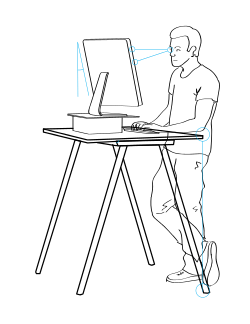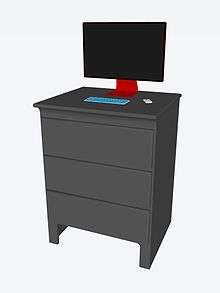Standing desk

A standing desk or stand-up desk is a desk conceived for writing or reading while standing up or while sitting on a high stool.
History
Several writers and statesmen wrote standing up: Thomas Jefferson, Charles Dickens, Winston Churchill, Ernest Hemingway, and Vladimir Nabokov. Some of them had specially made desks or lecterns.[1]
Variations


Standing desks have been made in many styles and variations. Standing desks may be specialized to suit particular tasks, such as certain variations of the telephone desk and desks for architectural drafting. Some standing desks may only be used while standing while others allow users to sit or stand by adjusting the desk height with an electric motor, hand crank, or counterbalance system. Some desks are also constructed like teacher's lecterns, allowing them to be set on top of an existing desk for standing, or removed for sitting.
While height of most seated desks is standardized, standing desks are made in many different heights ranging from 70 to 128 centimetres (28 to 50 in). Ideally the height of a standing desk fits the height of its individual user. With seated desks, adjusting the height relative to the user can be accomplished by adjusting the height of the user's chair. However, because users of a standing desk move around more than when seated, using a pedestal to adjust the user's height is not practical.
To solve this issue, a standing desk may either be custom-made, to suit the height of the user, or made with adjustable parts. For writing or drafting, the angle or slant of the surface may be adjustable, with a typical drawing table or table à la tronchin. If the desk is made for computer use, the legs may be adjustable. Another option is a platform made to sit on top of a regular seated desk that raises the desk's surface to a useful height for standing. Such platforms may be fixed height or adjustable.
A height-adjustable desk or sit-stand desk can be adjusted to both sitting and standing positions; this is purported to be healthier than the sit-only desk. Sit-stand desks may be effective at reducing sitting time during the work day between 30 minutes and two hours per working day but the evidence is low quality.[2]
Some antique standing desks have an open frame with drawers, and a foot rail (similar to those seen at a bar) to reduce back pain. A hinged desktop could be lifted in order to access a small cabinet underneath it so that the user could store or retrieve papers and writing implements without needing to bend over or stand back from the desk.
Effect on health
There is a significantly higher mortality rate among people who regularly sit for prolonged periods, and the risk is not negated by regular exercise, though it is lowered.[3][4]
Low-quality evidence indicates that providing employees with a standing desk option may reduce the length of time some people sit in the first year.[2] This reduction in sitting may decrease with time.[2] It is not clear how standing desks compare to other work-place interventions to reduce the length of time employees are sitting during the work day.[2]
There is no international consensus on recommended levels of sitting and standing while at work, and suggested workplace practices vary in different countries.[2]
There are only minor differences in energy expenditure between sitting and standing.[2]
See also
- List of desk forms and types
- Lectern, a type of upright desk
References
- ↑ Rybczynski, Witold (2016). Now I Sit Me Down: From Klismos to Plastic Chair: A Natural History. Farrar, Straus and Giroux. p. 198. ISBN 9780374713355.
- 1 2 3 4 5 6 Shrestha, Nipun; Kukkonen-Harjula, Katriina T.; Verbeek, Jos H.; Ijaz, Sharea; Hermans, Veerle; Pedisic, Zeljko (2018-06-20). "Workplace interventions for reducing sitting at work". The Cochrane Database of Systematic Reviews. 6: CD010912. doi:10.1002/14651858.CD010912.pub4. ISSN 1469-493X. PMID 29926475.
- ↑ Biswas, A; Oh, PI; Faulkner, GE; Bajaj, RR; Silver, MA; Mitchell, MS; Alter, DA (2015). "Sedentary Time and Its Association With Risk for Disease Incidence, Mortality, and Hospitalization in Adults: A Systematic Review and Meta-analysis". Annals of Internal Medicine. 162 (2): 123–32. doi:10.7326/M14-1651. PMID 25599350.
- ↑ van Uffelen, Jannique G. Z.; Wong, Jason; Chau, Josephine Y.; van der Ploeg, Hidde P.; Riphagen, Ingrid; Gilson, Nicholas D.; Burton, Nicola W.; Healy, Genevieve N.; Thorp, Alicia A. (Oct 2010). "Occupational sitting and health risks: a systematic review". American Journal of Preventive Medicine. 39 (4): 379–388. doi:10.1016/j.amepre.2010.05.024. ISSN 1873-2607. PMID 20837291.